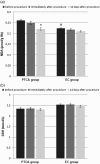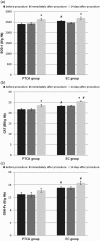The effects of percutaneous transluminal coronary intervention on biomarkers of oxidative stress in the erythrocytes of elderly male patients
- PMID: 27866469
- PMCID: PMC6837639
- DOI: 10.1080/13510002.2016.1257754
The effects of percutaneous transluminal coronary intervention on biomarkers of oxidative stress in the erythrocytes of elderly male patients
Abstract
Objectives: Oxidative stress plays a key role in the pathogenesis of coronary artery disease. The aim of this study was to compare the effects of percutaneous transluminal coronary angioplasty (PTCA) and elective coronary angiography (EC) on erythrocytic antioxidant defense in elderly male patients.
Methods: Twenty-three stable angina pectoris (SAP) patients undergoing PTCA and 18 patients with ischemic symptoms scheduled to undergo diagnostic EC were included in the study. The concentrations of malondialdehyde (MDA) and reduced glutathione (GSH) and the activities of Zn,Cu-superoxide dismutase (SOD-1), catalase (CAT), and cytosolic glutathione peroxidase (GSH-Px) were examined in the erythrocytes before, immediately after and 2 weeks following PTCA or EC.
Results: The MDA concentrations were significantly higher and SOD-1, CAT, and GSH-Px activities were significantly lower in the PTCA group than in the EC group at baseline. Two weeks after treatment, the activities of the enzymes significantly increased in both groups, whereas the MDA concentrations decreased only in the PTCA patients.
Conclusions: The results confirm that an advanced state of atherosclerosis is related to greater levels of oxidative stress. The study indicates that both procedures may induce antioxidant defenses; however, PTCA exclusively induces a long-term reduction in lipid peroxidation.
Keywords: Antioxidant enzymes; coronary angiography; coronary angioplasty; ischemic heart disease; lipid peroxidation; oxidative stress.
Figures


Similar articles
-
Lipid peroxidation and antioxidant enzyme activities in erythrocytes of type 2 diabetic patients.J Med Assoc Thai. 2010 Jun;93(6):682-93. J Med Assoc Thai. 2010. PMID: 20572373
-
Coenzyme Q10 supplementation reduces oxidative stress and increases antioxidant enzyme activity in patients with coronary artery disease.Nutrition. 2012 Mar;28(3):250-5. doi: 10.1016/j.nut.2011.06.004. Epub 2011 Oct 12. Nutrition. 2012. PMID: 21996047 Clinical Trial.
-
In-stent stenosis: potential role of increased oxidative stress and glutathione-linked detoxification mechanisms.Angiology. 2008 Aug-Sep;59(4):469-74. doi: 10.1177/0003319707309651. Epub 2008 May 25. Angiology. 2008. PMID: 18504266
-
Protection of coronary angioplasty-induced oxidative stress by Isovue used during angioplasty.Can J Cardiol. 1999 Sep;15(9):989-98. Can J Cardiol. 1999. PMID: 10504180 Review. English, French.
-
Evaluation of oxidative stress in patients with acute ischemic stroke.Rom J Intern Med. 2013 Apr-Jun;51(2):97-106. Rom J Intern Med. 2013. PMID: 24294813 Review.
Cited by
-
Role of Brain-Derived Neurotrophic Factor in Anxiety or Depression After Percutaneous Coronary Intervention.Mol Neurobiol. 2024 May;61(5):2921-2937. doi: 10.1007/s12035-023-03758-1. Epub 2023 Nov 10. Mol Neurobiol. 2024. PMID: 37946008 Review.
-
Oxidative stress and kidney injury in trans-radial catheterization.Biomed Rep. 2018 May;8(5):417-425. doi: 10.3892/br.2018.1071. Epub 2018 Feb 28. Biomed Rep. 2018. PMID: 29732146 Free PMC article.
References
-
- World Health Organization Global status report on noncommunicable diseases 2014. Geneva: WHO; 2014. (WHO publication, ISBN 978 92 4 156485 4). - PubMed
-
- Global Health Estimates 2014 Summary tables: DALYs by cause, age and sex, 2000-2012 [Internet]. Geneva: World Health Organization. [cited 2016 Apr 1]. Available from: http://www.who.int/healthinfo/global_burden_disease/en/
MeSH terms
Substances
LinkOut - more resources
Full Text Sources
Other Literature Sources
Miscellaneous
